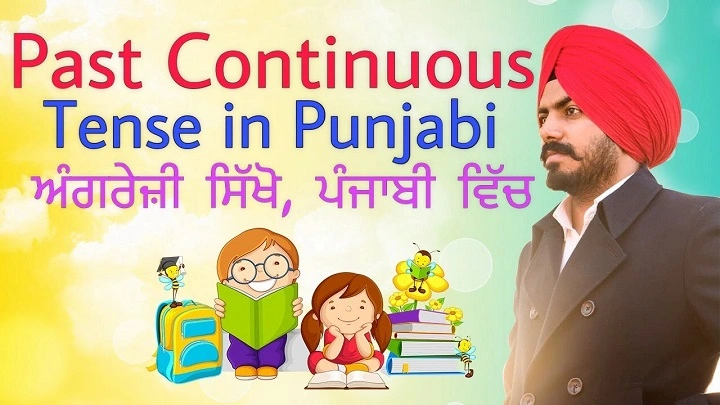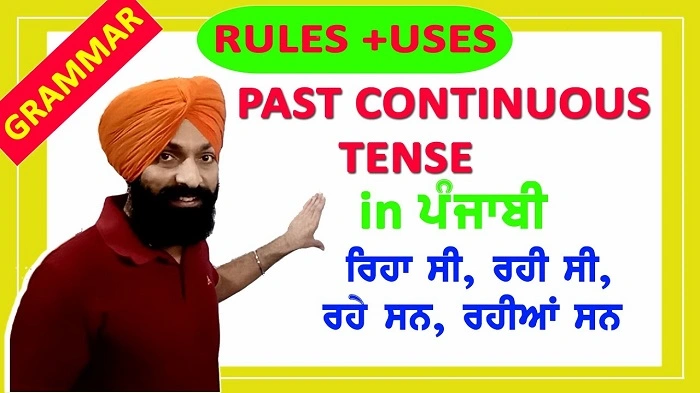If you allow it, learning languages is fun. As in English, likewise in Punjabi, tenses help us to know when something happened. Past Continuous Tense is a simple tense because we use it to describe action which was going on somewhere in the past.
For instance, we use the sentence, “I was reading.”
In Punjabi, for male you say Main parh riha si and for females you say Main parh rahi si.
It shows the action was going on earlier but has been done now.
What Is the Past Continuous Tense
Punjabi Past Continuous Tense tells us about the actions which were being performed for some period of time in the past. It enables us to explain what was in the process of being performed or what was occurring at some moment in the past prior to present time.
It is formed by:
- The subject (doer)
- Continuous tense of the verb
- Helping verb si or san when the subject is plural
It conveys a sense of “ongoing” with a “past” time reference.
Structure of Past Continuous Tense in Punjabi
While forming this tense, we have a simple form:
For singular subjects:
Subject + Verb Root + riha/rahi/riha si
For plural subjects:
Subject + Verb Root + rahe/rahiaan/rihe san
Helping verbs change on the basis of gender and number:
| Gender/Number | Helping Verb | Example in Punjabi | English Translation |
| Mother (Singular) | triha si | Memain kheḍ riha si | Mother was playing |
| Female (Singular) | rahi si | Memain kheḍ rahi si | I was playing |
| Male (Plural) | trahe san | Asin kheḍ rahe san | We were playing |
| Female (Plural) | trahiaan san | Oh kheḍ rahiaan san | They were playing |
Examples of Past Continuous Sentences in Punjabi
Main khaana kha riha si – I was eating food
Oh gaana gaa rahi si – She was singing a song
Asin film dekh rahe san – We were watching a movie
Tusin baahar ja rahe san – You were going outside
Oh kheḍ rahiaan san – They (females) were playing
Bachcha ro riha si – The child was crying
Every sentence is an action which went on for some period of time in the past.
How to Identify Past Continuous Tense in Punjabi
You can identify it if:
- The activity was happening in the past and hadn’t finished at the current point.
- The sentence has si or san and riha/rahi/rahe forms.
Examples:
Main so riha si – I was sleeping
Oh aa rahi si – She was coming
Wherever “si” or “san” follows “riha/rahi/rahe,” it can only mean Past Continuous Tense.
Negative Sentences of Past Continuous Tense
To make negative sentences, simply add nahi in front of the verb.
Form:
Subject + nahi + Verb (riha/rahi/rahe) + si/san
Examples:
Main nahi parh riha si – I was not reading
Oh nahi aa rahi si – She was not coming
Asin nahi kheḍ rahe san – We were not playing
Interrogative Sentences (Questions)
When you construct sentences in Past Continuous, the structure is slightly different.
Structure:
Ki + Subject + Verb + si/san
Examples:
Ki tusin khaana kha rahe san – Were you eating food
Ki oh parh rahi si – Was she studying
Ki oh kheḍ rahe san – Were they playing
Difference Between English and Punjabi Past Continuous
The tone is the same but in Punjabi sentence structure gender and number are involved while they are not involved in the English language.
| English | Punjabi (Male) | Punjabi (Female) |
| I was sleeping | Main so riha si | Main so rahi si |
| They were talking | Oh gall kar rahe san | Oh gall kar rahiaan san |
Use of gender form keeps Punjabi lively and expressive in nature.
Common Mistakes Most Often Committed Which Must be Avoided
Overuse of “si” in place of “san” for plural:
❌ Asin kheḍ riha si
✅ Asin kheḍ rahe san
Using the gender form on each other:
❌ Oh rahi san (wrong)
✅ Oh rahiaan san (correct when females are present too)
Omitting auxiliary verb:
❌ Main parh riha (not finished)
✅ Main parh riha si (finished)
Practice So
Step 1: Remember something you did last day or a week before.
Step 2: Translate it to Punjabi in Past Continuous form.
Example: “I was writing” → Main likh riha si.
Step 3: Use the same verb to form questions and negatives.
Example:
Ki main likh riha si (Was I writing)
Main nahi likh riha si (I was not writing)
Practice it repeatedly so that you become familiar with the tense without putting any effort on it.
Also Read: Compliance And Excellence: The Role Quality Standards Play In Modern Workplaces
Usage in Day-to-Day Life
Past Continuous is utilized to maximum level by Punjabi people in everyday life. Some of its day-to-day uses are illustrated below:
When speaking of something you were doing when another event occurred:
Main khaana kha riha si jad oh aaya – I was eating lunch when he came
When speaking of something in descriptive form:
Asin sadak te chal rahe san te meenh pai gaya – We were walking on the road and it began to rain
Therefore, these kinds of sentences are widely used in Punjabi novels, songs, and even in spoken language.
Simple Reminders
Si = singular, San = plural
Riha = masculine, Rahi = feminine, Rahe = plural (masculine/mixed)
Add prefix nahi to form negatives
Start with ki to form questions
Always use a past action as a prefix
Quick Summary Table
| Sentence Type | Punjabi Example | English Translation |
| Affirmative | Main parh riha si | I was reading |
| Negative | Main nahi parh riha si | I was not reading |
| Question | Ki main parh riha si | Was I reading |
FAQs
What is Past Continuous Tense in Punjabi?
It is a tense for something done in the past. i.e., “I was reading” or “She was cooking.”
How to construct the Past Continuous Tense in Punjabi?
Use the root word + riha/rahi/rahe + si (singular) or san (plural).
What is si and san?
Si is for singular forms, and san is for plural forms.
Is gender significant in Punjabi Past Continuous?
Yes, it is. The riha/rahi/rahe ending varies with gender.
Punjabi Past Continuous tense is only giving a description of what was going on in the past. If you are familiar with the pattern riha/rahi/rahe + si/san, then it is not difficult. With practice surely it will be convenient to describe past activities in the pattern of narration or conversation.
Another day then if ever you need to explain to anyone what you did yesterday in Punjabi, you’ll know how to do that.



